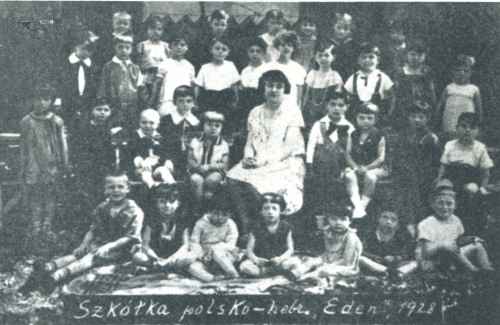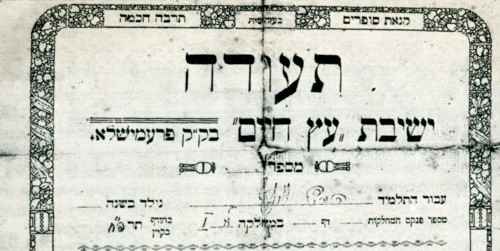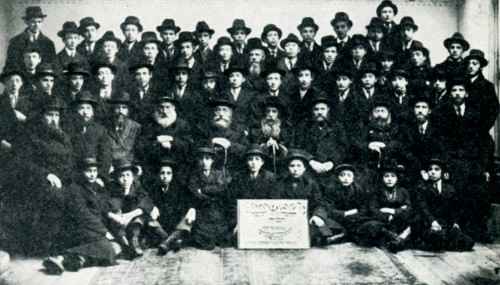 |
|
[Page 220]
The “Eden” Kindergarten
The town also had a private bilingual kindergarten (Polish and Hebrew), named “Eden,” managed by Ms. Genia Bien (now a teacher at an ulpan in Tel Aviv), where small children were educated in the spirit of national Judaism. The Hebrew songs which the infants learned in the kindergarten, and the celebrations held at Jewish holidays, imbibed the homes of the children's parents with a Jewish, Zionist atmosphere.
|
|
Vocational School for Girls
In 1920 Deborah[a] Citron initiated the establishment of a society for encouraging vocational education among Jewish youth: “Towarzystwo warsztatow dla mlodziezy zydowskiej.” The Society's first activity was an educational workshop, which was opened in a rented apartment on Dworskiego St. The fist students, mostly young women who had been orphaned during the Fist World War, studied sewing and embroidery, taught by professional teachers, and were paid for their work. The girls' level of education was extremely poor, because they had barely had any schooling, due to the war. Deborah Citron's daughter, Dr. Olga Citron[b] , devoted her spare time – at the time she was a teacher at the gimnazjum for girls – to improving the girls' education, and she taught them general knowledge in the framework of an elementary school.
This educational workshop served as the basis for a proper vocational school, which was established in 1924, under the direction of Dr. Olga Citron, who devoted all her energy, education, and admirable qualities to the development of the institution. It was not by any means an easy task during those times, to impart to certain strata of the Jews of Przemysl the recognition that girls must also be given a respectable vocational training, and that vocational school was not intended only for the ungifted. By means of systematic publicity, Dr. Citron managed to earn the trust of the parents, and the number of girls registered for the school increased each year.
[Page 221]
|
|
|
|
The school had a three-year curriculum, and met the requirements of the Ministry of Education and Culture. Hebrew studies were compulsory. Apart from scholastics, the girls studied sewing, embroidery, weaving and carpet-making. Classes in home economics were added in 1931, and a learning kitchen was opened. The school held evening classes in sewing and cooking, for adult students.
During its first years, the school operated in a rented apartment, in the house owned by Y. Thumim. Later, it moved to a building at 12 Lukasinskiego St., built in 1929 with the financial support of the J.C.A company (“Ika”), and with contributions from various public groups and private individuals. J.C.A also provided the equipment, such as sewing machines, looms, etc.
The school budget was partially covered by the tuition and the workshop income. J.C.A and the Ministry of Education and Culture gave a fixed annual support to the school. The school also had a committee of 7 members, chosen from among Przemyśl public figures, which served as an advisory board for the school management
[Page 222]
in organizational and budgetary problems. The committee included: Dr. Jacob Glanz, Shmuel Babad, Prof. G. Teich, Dr. A. Schutzman, Dr. I. Sohn. The secretary was Chana Seldowitz-Epstein (now in Jerusalem).
In 1938 there were 170 students in the school.
The composition of teachers in the institution was as follows: Dr. Olga Citron, Ms. Karua[c] , Ms. Rosa, the Seldowitz sisters, Ms. Hecht, Mgr. Schwadron, Zisie Taub, Jacob Koritan.
|
|
In the middle, Dr. Olga Citron |
[Page 223]
Boarding School for Apprentices
One of the institutions which was the pride of the Jewish community in Przemyśl was the Noar Haoved “Bursa” boarding school, “Bursa zydowskiej mlodziezy rekodzielniczej.”
The initiators of the boarding school were craftsmen from the “Yad Charutzim” society. In 1926, when the economic crisis severely damaged the Jewish workshops, they were unable to keep and pay for apprentices. The number of people training in crafts was decreasing, and at the same time the options for productive education of large sectors of the youth, were diminishing. The activists believed that the establishment of a boarding school, where the trainees would live and also acquire a profession, under the guidance of experienced craftsmen, would solve the problem.
The boarding school was built on a lot dedicated for this purpose by the City of Przemyśl in 1927, on King Leszczyński St. “Yad Charutzim” set up the building committee, which was comprised of the engineers: S. Schaffer[d] , M. Jawetz, H. Bazar, A. Guttman, Dr. Scheinbach and M. Schatzker. A special society by the name of “Friends of the Jewish Working Youth School” was established, led by: Leon Nessenfeld, Dr. Gottdank, Josef Strudler, Friedmann, Leib Pillersdorf, Reinhartz and Dr. Izaak Sohn. It began to raise the necessary funds.
The City of Przemyśl gave 25,000 for this purpose. The municipal savings fund contributed 5,000 zloty, the Jewish community gave 20,000 zloty, and the Jewish public contributed 45,000. The cornerstone of the building was erected on April 17, 1935.
The planning and supervision were carried out by engineer Slo Schaffer[d]. The building had two stories, and was equipped with all conveniences, able to house up to 100 students. A spacious dining room was built, as well as a library room, showers, study rooms and housing.
The house-warming was held on February 2, 1937, with the presence of the city dignitaries. The following words were engraved on the memorial plaque which was set in the entrance to the building:
The Society of Jewish Craftsmen, “Yad Charutzim,” dedicates this temple to the Jewish Noar Haoved, to be a place for the formation of character, the molding of fine character, the nurturing of love for the crafts, and education towards good citizenship.
|
|
[Page 224]
Religious Educational Institutions
1. Talmud Torah
The institute was housed in its own building by the “Beit Talmud” society, headed by Abraham Diller, a religious activist in town.
The number of students in 1938 was 150. Most of them were children of poor families who were unable to afford tuition. They studied Torah, according to the traditional cheder curriculum. The teaching staff included a headmaster and four teachers. The annual budget was small, roughly 9,000 zloty (1,800 dollars). The community contributed a sum of 1,200 zloty, and the rest was covered by membership fees and by collections taken from time to time.
2. “Bais Yakov” School for Girls
The religious school for girls, “Bais Yakov,” was maintained by a society of the same name. There were approximately 120 students there, some 40% of whom paid no tuition. The students received a religious education acceptable for religious women, and general education at the level of an elementary school. The institution was mainly supported by donations from the kahal and from a small contribution from the community, in the amount of 600 zloty a year (120 dollar).
The institution was directed by Abraham Diller.
|
|
The sign held by one of group members says: “Beit Talmud Society. Przemyśl”. (ed.) |
3. “Eitz Haim” Yeshiva
The yeshiva was comprised of three classes, and some 200 students. It had no building of its own, and was spread over three locations – in the klois, in the minyan of the Vassyatin Chassidim, and at Rabbi Itzeleh[e] . Each class had an educational supervisor, whose duty was to teach the children Torah and good manners.
The first class was a kind of preparatory class for the study of Gemara, and was managed by the melamed[1] Rabbi Itscheleh[f] .
The second class taught more intensive knowledge of the Gemara and introduced the world of the poskim[2]. Its teacher was Der Istriker[g] The third class prepared the students for their own mastery of the Shas[3]
and the poskim, as well as introducing them to the broad world of Din Yisrael. The teacher of the third class was Der Birtscher[h] . After finishing the third class, the students could elect to study at the
high yeshiva, to obtain Rabbinical ordination.
The yeshiva was directed by Yisrael Siedwartz and Shlomo Hister.
[Page 225]
The Yeshiva was established in 1924 by the Council of Gdolei Hatorah in Poland, belonging to “Aggudath Yisrael,” under the leadership of
Rabbi Meir Shapira from Lublin. Some 200 young men from Przemyśl and the
environs studied in it. The studies were held in the “ezrat hanashim”[5]
in the klois, and in the great Beit Midrash. The curriculum included shas and poskim.
The Yeshiva directors were Rabbi Shimshon Fogelman and Rabbi Shabtai Segal. The
committee in support of the Yeshiva, which was supported by the
“Aggudah,” included: Rabbi Efraim Nussbaum, Rabbi Hershele Steiner,
Rabbi Jacob Hirschfeld, Rabbi Shmuel Babad, the head of the community, and
Rabbi Yehoshua Wiederkehr, the presiding judge in the town, Meir Liebreich[i], Abraham Diller, Feibel Jolles and Motel Laub.
From among the students of the Yeshiva, the following are in Israel: Rabbi
Efraim Weinberger[i] , rabbi of the “Yad Eliyahu” neighborhood in Tel Aviv, Shalom
Rokeach, Shlomo Tuchman (Sollel Boneh[6]) , Moshe Schwartz (Kupat-Am[7])
, and Moshe Wilner.
Original Footnote:
Translator's Footnotes:
Coordinator's Footnotes:
JewishGen, Inc. makes no representations regarding the accuracy of
the translation. The reader may wish to refer to the original material
for verification.
Copyright © 1999-2025 by JewishGen, Inc.


fulfilling our
mission of disseminating information about the Holocaust and
destroyed Jewish communities.
This material may not be copied,
sold or bartered without JewishGen, Inc.'s permission. Rights may be
reserved by the copyright holder.
JewishGen is not responsible for inaccuracies or omissions in the original work and cannot rewrite or edit the text to correct inaccuracies and/or omissions.
Our mission is to produce a translation of the original work and we cannot verify the accuracy of statements or alter facts cited.
 Przemyśl, Poland
Przemyśl, Poland
 Yizkor Book Project
Yizkor Book Project
 JewishGen Home Page
JewishGen Home Page
Yizkor Book Director, Lance Ackerfeld
This web page created by Osnat Ramaty
Updated 22 Aug 2025 by LA